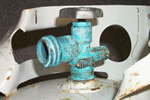Ammonia is stable but very reactive.
-
 Stable to heat and light.
Stable to heat and light. - Reacts violently and explosively with oxidizing gases such as chlorine, bromine, and other halogens.
- Reacts explosively with hypochlorites such as bleach.
- Reacts vigorously with acids.
- Highly reactive with reducing agents.
- Forms explosive compounds with silver and mercury.
- Hazardous polymerization will not occur. Polymerization is the formation of long organic or inorganic chemical chains.
- Ammonia is a nonflammable gas, but it will ignite within vapor concentration limits of 15 percent and 28 percent at a temperature of 1204°F. Complete combustion forms oxides of nitrogen and water vapor.
- Corrosive to copper, zinc, tin, brass, and galvanized steel surfaces.
- Not corrosive to mild steel, glass, or stainless steel (304 or 316).
Dissolves in water with the evolution of heat to form ammonium hydroxide. Action upon contact is vigorous

